Komodo dragons and grizzly bears are two animals that would scare the daylights out of most humans if they found themselves faced with one.
Yet, it’s always worth wondering which one is stronger and more capable of winning a battle against the other. That’s why we’re going to create a hypothetical matchup between a Komodo dragon vs. a grizzly bear.
We are going to break down this fight into smaller components to show you which animal has superior strength, size, and other qualities to help them win this battle.
You’ll have a very good idea of which animal is bound to win the fight at the end of this article!
Comparing a Komodo Dragon and a Grizzly Bear

| Characteristic | Komodo Dragon | Grizzly Bear |
|---|---|---|
| Size | Weight: between 150 and 200 pounds, up to 350 pounds Length: from 6 to 10 feet Height: up to 2 feet tall | Weight: between 400 and 700 pounds on average, but they can weigh up to 1,200 pounds. Height: 3 to 3.5 feet at the shoulder Length: from 7 to 10 feet long, with the latter measure being very rare |
| Speed | – Can run at about 10 to 13 mph – Adept swimmers | – Can reach maximum speeds of 35 mph |
| Defenses | – Their speed could help them get away from some predators in their range – Their skin is reinforced with osteoderms to protect them from bites and blunt force – They can sense prey from very far off using their sense of taste and Jacobson’s organ | – Powerful creature that is hard to bring down – Has the speed to escape from fights – The body is protected by a layer of fur, skin, and fat that can be several inches thick |
| Offensive Capabilities | – Complicated bite that may or may not be venomous – Have a dangerous bite using short but sharp teeth to exsanguinate prey – Use their sharp claws to grab and hold prey while biting them | – Powerful bite that reaches 975 PSI – Canine teeth that measure up to 3 inches are used to cause significant injuries to vital areas – Claws can measure upwards of 5 inches – Powerful paw swipes – Combines attacks to maul prey |
| Predatory Behavior | – An ambush predator that can still pursue prey if they fail to kill with their first strike – Usually tries to bring their prey to the ground with a bite and their body or even using their tail – Attacks and injures prey and then eats it, often while still alive | – Rarely a predator, but they do have predatory instincts – Somewhat cursorial but also try to start fights with an ambush charge |
What Are The Key Differences Between a Komodo Dragon and a Grizzly Bear?
The biggest differences between a Komodo dragon and a grizzly bear can be found in their size and morphology. Grizzly bears are very large quadrupedal mammals covered in thick fur that usually weigh between 400 and 700 pounds, while Komodo dragons are quadrupedal reptiles with long tails that weigh between 150 and 200 pounds for the most part.
These animals are very different from one another in terms of their body types. Yet, those key differences are not enough to say which creature will win this battle. Let’s take a closer look at other data points to see which animal is most likely to win a fight.
What Are the Key Factors in a Fight Between a Komodo Dragon and a Grizzly Bear?
The key factors in a fight between a Komodo dragon are attack power, predatory behavior, and offensive capabilities. These elements will determine which animal has a shot at winning this fight. However, we will also examine speed and defense to give us further insight into these creatures and their prowess. With five total factors explored, we’ll assign advantages to each animal and then use all the data to determine the winner!
Komodo Dragon vs. Grizzly Bear: Size
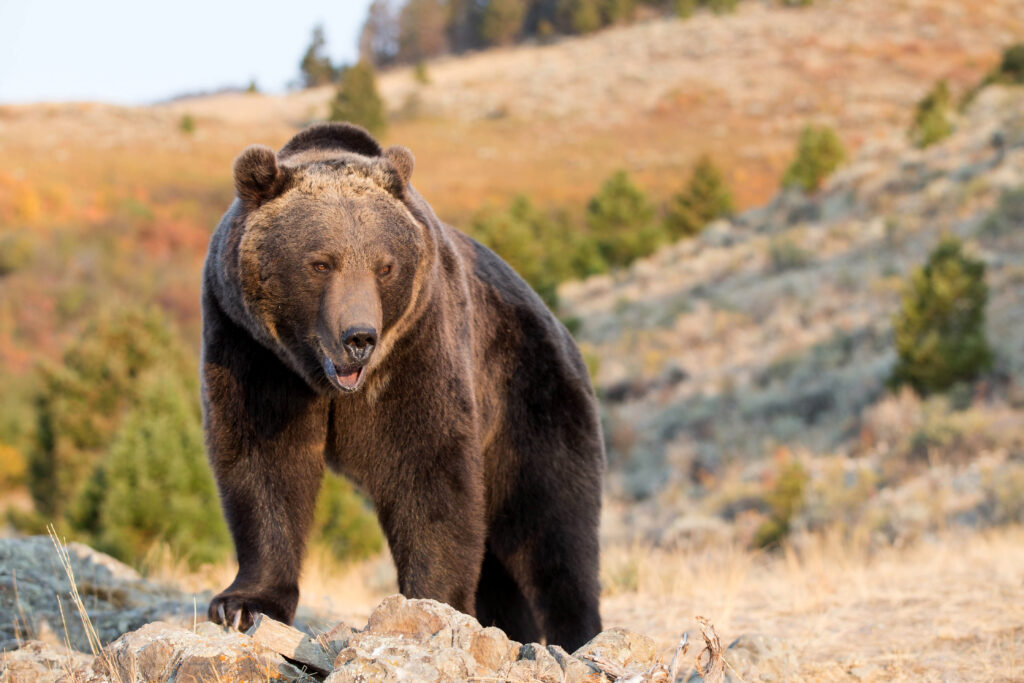
Grizzly bears are larger than Komodo dragons.
©Dennis W Donohue/Shutterstock.com
Grizzly bears are much larger than Komodo dragons. The average Komodo dragon weighs between 150 and 200 pounds, but they can get larger. Also, they grow between 6 and 10 feet long and stand about 1.2-2 feet tall at the shoulder.
Meanwhile, grizzly bears can weigh between 400 and 700 pounds on average, but they can also weigh over 1,000 pounds at their largest. They stand between 3 and 4.5 feet tall at the shoulder and grow between 7 and 10 feet long. Yet, the larger measures are rare.
Still, the grizzly bear has a size advantage in this battle.
Komodo Dragon vs. Grizzly Bear: Speed
Grizzly bears are much faster than Komodo dragons. The average Komodo dragon runs between 10 and 13 mph on land. Grizzly bears can hit speeds of 35 mph when they are running at full speed. The Komodo dragon’s short legs and scrambling gait limit its speed, but the grizzly’s powerful front legs allow it to accelerate and run quickly.
Grizzly bears have a speed advantage in this fight. The Komodo dragon won’t have the chance to run away.
Komodo Dragon vs. Grizzly Bear: Defenses
Grizzly bears have solid defenses. Their fur is dense, their skin is thick, and their bodies are very fatty. All that means is it’s going to be hard for something to do enough damage to cause serious enough damage to kill the bear. Grizzly bears are also very powerful, so an animal would need to be even bigger and stronger to put them down.
Also, grizzly bears can run away from harm and have good senses to detect other animals in their immediate area.
Komodo dragons can hide well and use their decent speed to get out of harm’s way. In a fight, they have osteoderms on their skin that reduce the impact of bites, cuts, and blunt damage to a degree. Their skin is not impenetrable, though.
Both animals are evenly matched in terms of the types of defenses they have, but grizzly bears have more effective defenses.
Komodo Dragon vs. Grizzly Bear: Offensive Capabilities
Grizzly bears use numerous methods to attack their prey. First off, they have their bite. The bite force exerted by these bears can reach 975 PSI. When combined with their 3-inch-long canine teeth and others, bears can bite their prey on the back or head and kill it instantly in some cases.
Grizzly bears also like to claw and swat their prey. Their claws can reach lengths of 3 to 5 inches. Even though they’re not very sharp, they can still cause significant injuries. Grizzlies are big fans of mauling their prey. They bite, swat, climb on, and slash their prey to death in a vicious assault.
Meanwhile, Komodo dragons use their bites to kill their prey. Let’s make something clear: a Komodo dragon is not venomous in the same way that a king cobra is venomous. It can’t bite the grizzly and wait for it to die. Their venom, at best, is believed to assist with inflicting shock and exsanguinating prey.
Their other weapons are their claws, but they are typically used to restrain prey. Komodo dragons are very effective at attacking and killing animals larger than themselves, though. They can knock down their prey and deliver several razor-sharp bites before it has a chance to fight back or run away.
All in all, grizzly bears have an advantage in offensive powers due to their combination of deadly attacks.
Komodo Dragon vs. Grizzly Bear: Predatory Behavior

Komodo dragons are adept ambush predators.
©iStock.com/kiwisoul
Grizzly bears don’t hunt all that often. Instead, they gather food and scavenge. However, they can hunt using some ambush tactics as well as cursorial tactics. They’ll happily chase down and kill their prey.
Komodo dragons also scavenge when they have to, but they’re adept ambush predators. One of the largest types of prey they hunt is deer, and they frequently catch them despite the disparity in speed. They’re good ambush predators that can quickly do serious damage to prey without sustaining much damage.
Komodo dragons are more frequent predators than grizzly bears, so they get the advantage in this category.
Who Would Win in a Fight Between a Komodo Dragon and a Grizzly Bear?
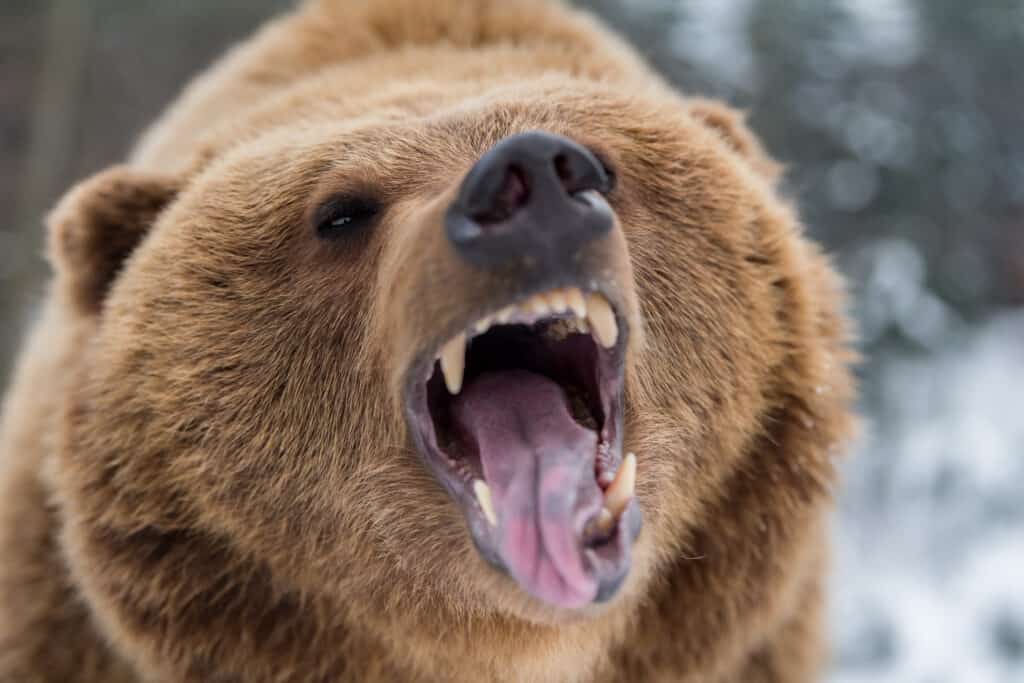
A Grizzly bear would win the battle against a Komodo dragon.
©Volodymyr Burdiak/Shutterstock.com
A grizzly bear would win a fight against a Komodo dragon, but the fight would be bloody and intense. Let’s imagine that they meet on even ground, and no ambush occurs. The grizzly bear likes to start a fight with a fast charge.
When the two animals crash into each other, the Komodo dragon will go for a bite at any vital part it can reach. It can’t reach any of those on the bear, though. Instead, they will go to the flank and legs of the bear until they can bring it down. Unfortunately, the grizzly bear is way too strong for the Komodo dragon to bring to the ground and kill. The grizzly overmatches the Komodo dragon for raw power, and it will dig in and start beating and clawing the creature while using its body weight to pin it down.
With 700 to 1,000 pounds pressing down on it and delivering vicious bites to its head, neck, and back, the Komodo dragon’s fight against the grizzly bear is going to be short-lived.
The reptile will certainly cut the grizzly’s skin, causing it to bleed and potentially using its venomous saliva to cause extra bleeding. However, the Komodo dragon’s teeth are only about 1 inch long, so they would need to bite the grizzly bear many times to cause enough damage to finish the mammal.
In that interim, though, the grizzly will break the Komodo dragon’s back, puncture its skull, and bat it around until it’s dead. The grizzly bear is the winner.
What Do Komodo Dragons Eat?

Komodo dragons will eat just about any animal that they can catch.
©vladivlad/Shutterstock.com
Komodo dragons hunt by using their keen sense of smell to locate prey, even if it is miles away. They are also known for ambushing and then overpowering their victims with a series of vicious bites. Once they attack, the Komodo dragon will use its sharp claws and serrated teeth to tear off chunks of flesh until the animal dies from shock or blood loss.
Their diet consists mainly of carrion (dead animals), although they do have a taste for live prey such as birds, snakes, deer, wild boar, and other lizards. If given the opportunity, they may even consume water buffalo or humans! They also opportunistically feed on eggs when available. Their diet is highly variable depending on what food sources are available, but it typically includes mammals, birds, reptiles, and invertebrates like insects.
What Do Grizzly Bears Eat?
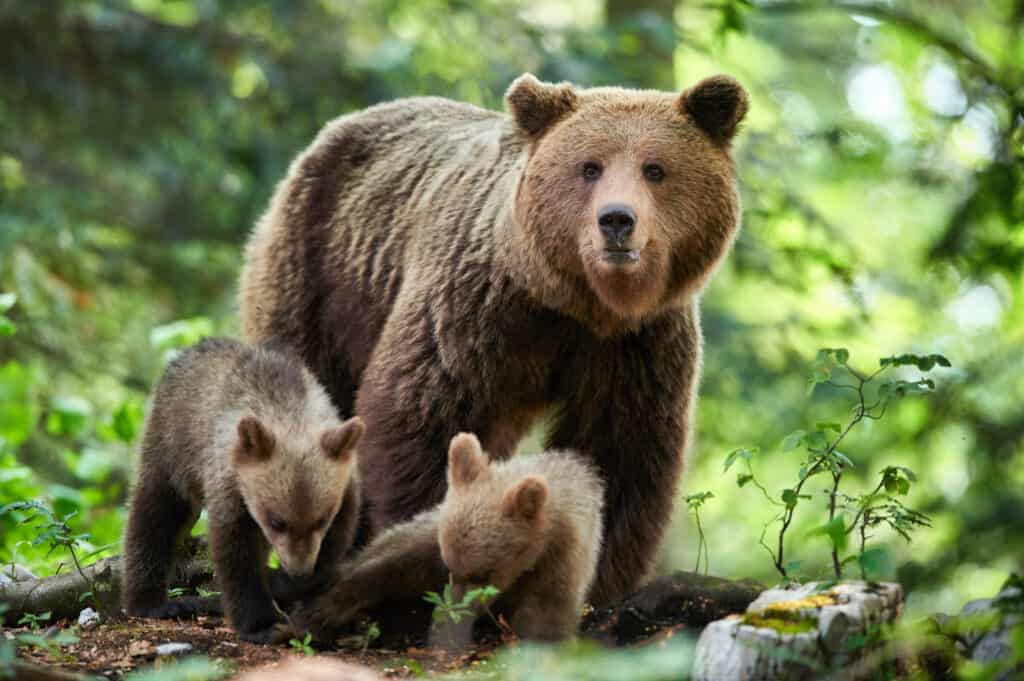
Grizzly bears are opportunistic hunters and eat a wildly varied diet.
©Piotr Krzeslak/Shutterstock.com
The typical diet of a large grizzly bear consists of a variety of different food sources. They are opportunistic feeders, meaning they will eat whatever is available to them. This includes fish, berries, nuts, roots, and even carrion (the flesh of dead animals). In the summer months, they may also dine on fruits and vegetables. Grizzlies have been known to raid beehives in search of honeycomb during their annual cycle. It’s important for us humans to remember that these powerful animals are simply trying to survive like any other species on Earth.
Komodo Dragon Conservation Status

Komodo dragons are endangered species.
©Ltshears – Public Domain
Komodo dragons are listed as endangered by the International Union for Conservation of Nature (IUCN), with their population decreasing in recent years. The main threats to these animals include habitat loss due to human development, poaching, and competition from introduced species. There are thought to be less than 5,000 alive on earth.
Climate change is predicted to have an effect on Komodo dragon populations in the future. To help protect these creatures, conservation efforts have been implemented across Indonesia, including creating protected areas specifically for Komodo dragons and reducing hunting within their native range. Other measures that could be taken include increasing public awareness about the importance of conserving these animals and enforcing laws that protect them.
Grizzly Bear Conservation Status
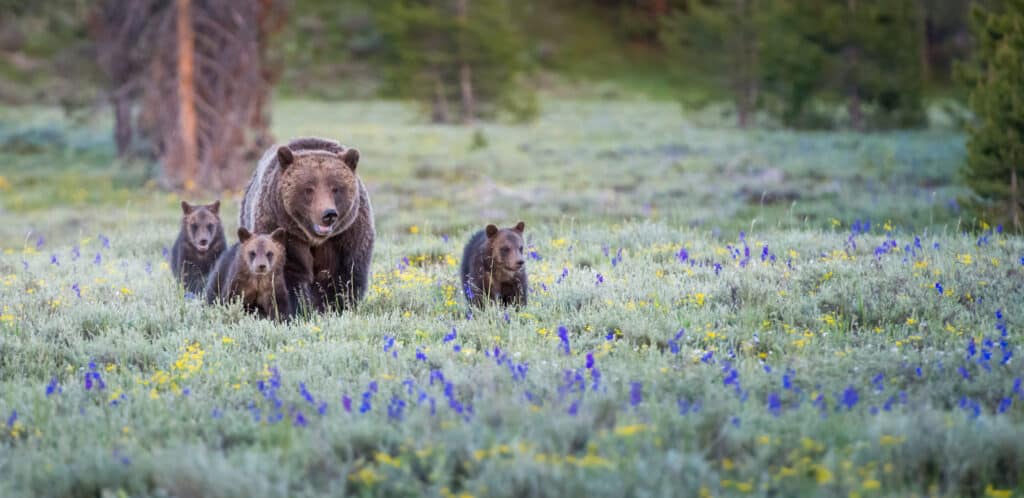
Grizzly bears are a threatened species due to many threats from humans.
©iStock.com/Jillian Cooper
Grizzly bears are listed as a “threatened” species under the Endangered Species Act, meaning that although they are not currently in danger of extinction, their population is declining and facing threats from many sources. The major threats to grizzly bear survival include habitat destruction, poaching, motorized recreation activities in backcountry areas, and conflicts between humans and bears due to improper garbage disposal and other human-bear interactions.
According to the US Fish and Wildlife Service, 1,500 individual grizzly bears were living throughout the United States in 2007. However, due to the continued loss of habitat and increased human activity near these habitats over time, this number has likely decreased to 700 – 800 grizzly bears left in the Lower 48 states (outside Alaska).
What Other Animal Can Take Down A Grizzly?
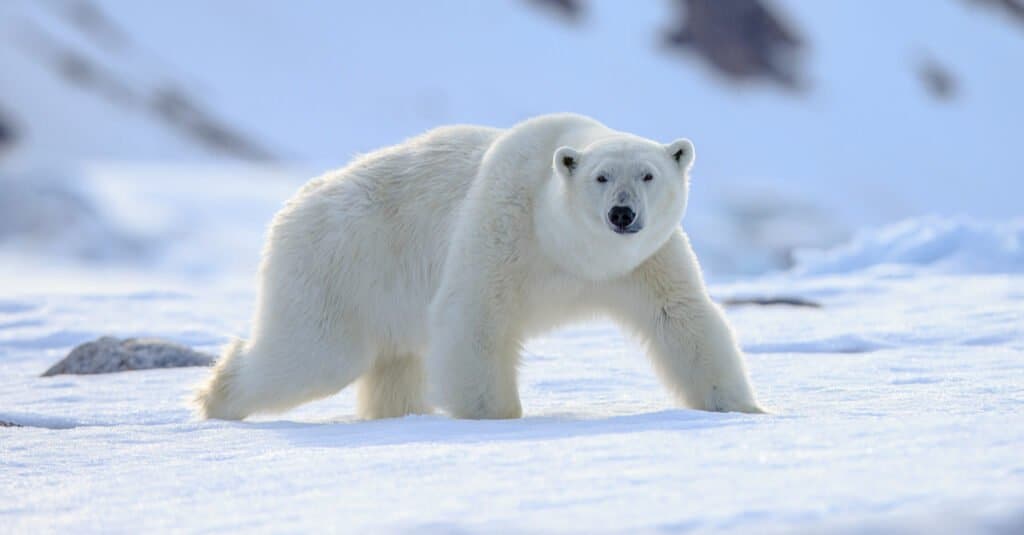
A hypercarnivore, the
polar bear
is capable of outdoing the grizzly in terms of bulk, bite force, and brute strength.
©Vaclav Sebek/Shutterstock.com
It would take a foe capable of matching the grizzly in bulk, bite force, and brute strength to even have a chance at taking it on. In other words, another apex predator. Not many creatures in North America fit the bill, however, there is one which is just right:
The Polar Bear: The creature known as Ursus maritimus is quite simply the largest bear species on the planet. Known to tip the scales at 1,500 lbs, the largest polar bear ever weighed was 2,210 lbs. The polar bear is also capable of reaching a height of 8.4 feet. The hypercarnivore has a bite force of 1,235 psi which exceeds the grizzly’s at between 975 and 1,160 psi.
The polar bear is also capable of heaving immense chunks of ice weighing over 1,000 lbs, the maximum weight a grizzly is capable of handling. Add to that the former’s longer reach and a swipe force of 1,800 lbs and it is likely the polar bear will emerge the victor in the event of these massive predators squaring off against each other.
The photo featured at the top of this post is © Volodymyr Burdiak/Shutterstock.com
Thank you for reading! Have some feedback for us? Contact the AZ Animals editorial team.






